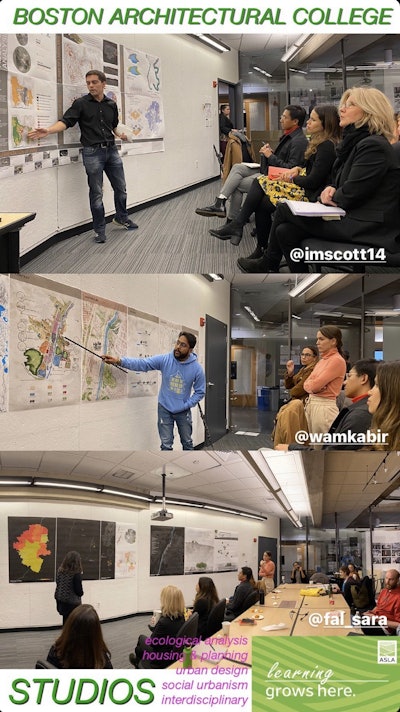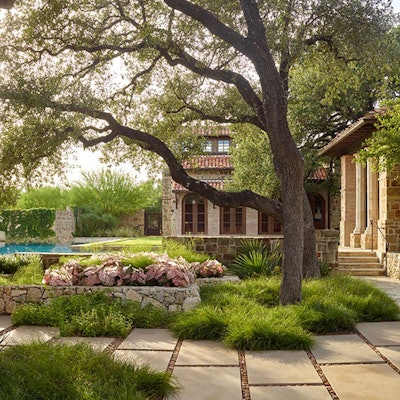 Photo: ASLA
Photo: ASLAWith April dedicated to World Landscape Architecture Month (WLAM), landscape architects across the globe took to the internet to share their stories and photos of their favorite green spaces.
Students of landscape architecture also took this time to show their support for the industry, as well as showcase why they love being part of this field. While interest in this field has grown over the years, it’s true that many middle, high school and undergraduate students are still unaware that this career option is even available by the time they get to college.
“It’s such a small profession, and it doesn’t get a lot of notoriety,” says Michael Radner, ASLA, principal at Radner Design Associates, Inc. in Framingham, Massachusetts. “But I have seen that change over the course of my career, so I think we’ve done a pretty good job as a profession with getting the message out.”
Maria Bellalta, ASLA, dean of the school of landscape architecture for the Boston Architectural College (BAC), chairs the American Society of Landscape Architect’s (ASLA) education committee and has wondered time and time again how they can better spread the word about landscape architecture.
Starting young
One of the most notable discoveries Bellalta says ASLA has made is that the best time to introduce landscape architecture to students is while they are in middle school.
“I would say for many years we have also been subsumed by the architecture industry or architecture and engineering,” says Bellalta. “That’s something we’re trying to grow out of, and we’re also trying desperately to advocate for landscape architecture to become a STEM discipline.”
Most landscape architects say they didn’t learn about this field of study until well into their college years or even after graduating, and this is a problem Radner, Bellalta and Andrew Wickham, ASLA, project designer at LPA, Inc. in Sacramento, California, desperately want to fix.
From her time in the academic world, Bellalta notes that many students who are introduced to this field young come from families of landscape architects or landscape architect educators, as opposed to learning about it in school.
Bellalta says ASLA is continually working to visit more schools and career fairs to really expose students to this industry as early and as often as possible. This outreach, ASLA says, is going to be a critical component in growing the field.
 Photo: ASLA Instagram
Photo: ASLA InstagramStudent demographics
The BAC is a design only institution with approximately 700 students. Bellalta says design thinking is at the core of the college, and training designers on how to understand and actually build is paramount.
Due to COVID-19, the school has transitioned to online learning for the foreseeable future.
“My programs are fairly young, but we’re doing great work and I’m very excited about it,” says Bellalta. “My students are really diversifying the profession because I get students from all walks of life, not just diversity of ethnicity or culture but also of economic diversity. That means that it’s no longer a white man’s profession; it’s many thinkers putting their heads together and addressing real issues that affect communities worldwide.”
Bellalta notes that half of her students are female, which is a notable spike compared to previous years, and 22 percent are international students from Latin America, the Middle East and China. Twenty-five percent of Bellalta’s students are undergraduates and 75 percent are graduates.
Since starting at the BAC, Bellalta says she has seen a shift in the age range of the graduate students. For instance, she notes that graduate students used to be older or second career changers. Now, she says more are either coming directly from the undergraduate track or are taking a gap year before pursuing the graduate program.
Graduate students now range in age from mid-20s to mid-30s, as opposed to mid-40s, as it has been in the past. This, Bellalta says, proves that awareness is getting out.
“Landscape architecture can be a part of the solution for social justice inequities, environmental justice, economic issues, climate change, resilience, fires and more,” says Wickham. “Landscape architects are dealing with these on a daily basis and their projects are helping to alleviate or provide solutions for those problems.”
Choosing this field
 Photo: ASLA
Photo: ASLAWhen trying to recruit to your career field, it’s imperative that you fully understand why the path is worth traveling.
“When I first started, I knew that it was construction-related industry, and my attitude was always that I was in it for the environment and the people,” says Radner. “I would rather be working on the inside of a profession in an industry that if we’re going to build something, let’s build the best thing that we can that can help heal the earth.”
Radner says he’s been in this industry for 30 years and has never been bored a single day. Every day and every hour, he says there’s something new, and no two projects are ever the same. He adds that he is constantly learning something new in this field, and he enjoys the teammates he gets to work with.
“It’s a constant evolution for me as a professional,” says Radner. “Whether you’re working with a team that you’ve worked with 20 times before or you meet somebody new, a new energy comes from that. I find that very gratifying.”
For Wickham, landscape architecture spoke to him because it is all about the end-user. Working with LPA, Wickham says he’s gotten to see true sustainability in practice, as the firm works to be as sustainable as possible with all of their projects.
Wickham says a large part of his work is K-12 education design, and he loves seeing the impact outdoor learning spaces have on both the teachers and students.
“It’s just so rewarding to see how they light up, how excited they get and how passionate they are to learn about that connection they get with nature,” says Wickham. “Knowing that I’m a part of that, that I am making the world a better place is incredibly rewarding as well. For me, I know that I’m doing all that I can to make the world a better place every day.”
“When the landscape architect comes to the table, we bring the green and we’re able to talk on both the artistic side of it and the engineering side of it,” says Radner. “I think that gives us more authority. When we come to a meeting with a client, we’re seen as good guys, and if there’s going to be an impact on the community, we can help mitigate those impacts or make a project better.”
 Photo: ASLA
Photo: ASLA








